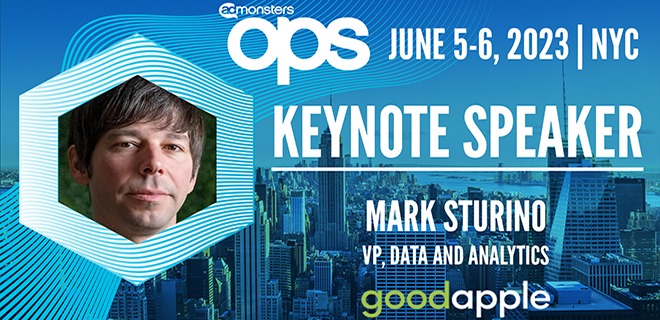
Before he became a leader in database analytics, Mark Sturino led in the classroom. One of his earliest jobs was as a second-grade teacher at a bilingual school in Mexico.
Being a teacher taught Sturino how to interact with people, deal with situations, and simplify concepts – skills he regularly uses as VP of Data and Analytics at media agency Good Apple.
“I taught a room full of second-graders working in their second language. I was trying to simplify concepts and pay close attention to what the kids had to say – every day, every word, every phrase,” remembered Sturino. “It was similar to being a data analyst. It’s so easy to talk above somebody’s head, but you must ensure you understand your audience and simplify it.”
Throughout his decade-long tenure at Good Apple, Sturino grew the data science practice into a trusted and integral capability. During his keynote, “How AI is Reshaping Media Buying and Selling,” at the AdMonsters Ops Conference, Sturino will share how media agencies and publishers can best incorporate AI to solve challenges from ad effectiveness and consumer engagement to brand safety and cross-device targeting.
From Baseball Cards to Mathematical Theorems
From an early age, Sturino was always a numbers person.
“I was one of those kids who looked at the stats on the back of my baseball cards. I’d have two different cards, and if one player had a better batting average and the other player had more RBIs, I’d try to figure out who was the better player,” recalled Sturino.
In college, Sturino enjoyed a mathematical proofs class where he had to make a case to prove the validity of a theorem. Finding joy in the exercise, he also learned patience for thinking through multistep processes and the curiosity to understand them.
“I think patience is a big part of what makes a good analyst. It is more than being good with numbers. You must also understand where the numbers came from, the conditions under which the data was gathered, or how it joins with other data,” said Sturino. “How everything comes together is a lot like building that proof.”
Sturino says that although the theorem is used in higher math, you must build the theorem first, and he thinks that realization was how he ended up working in data and analytics.
Every Apple Is an Analyst
At Good Apple, Sturino ideated and led the development of Crisp, the agency’s first proprietary data integration and management platform. Crisp was born out of necessity. It started with noticing how a client report was time-consuming, involving multiple team members, and several data sources. That time and effort were not sustainable.
“I think where we saw an opportunity was not in solving the problem at hand but looking at the bigger problem overall and building a structure that worked for where we want to be in five years,” said Sturino.
Good Apple’s philosophy is that every Apple is an analyst. The media and analytics teams are heavily integrated, and the development of Crisp has been organically driven by analysts building tools that solve the problems they see in the teams’ everyday work.
Working closely with the agency’s pharmaceutical and retail clients, Sturino uses the Crisp AI capabilities to help pharma clients leverage an automated tool for creating custom content scans. Crisp interprets what is on a page, compares it to what’s allowed within that content space, and alerts Good Apple’s teams when something’s wrong.
“Crisp is that first line of defense that can work faster and more often than a human could. We’re still doing our checks, but we’re adding an additional layer on so we can be more compliant,” said Sturino. “I think it’s an overabundance of caution that you see in the pharma space, and AI can play a big role in helping to add to that.”
AI’s Impact Across Media Buying and Selling
Good Apple builds relationships with publishers and focuses on understanding what’s happening within a media interaction. When it comes to AI, Sturino thinks publishers can differentiate themselves by leveraging the tech to provide insights and transparency.
“If you look at where we started with pixel optimizations from programmatic partners, they have a pixel on the site and say they will automate towards this. But you never really learn what changes it’s making or what audiences it’s chosen to bid on. You get some information, but you don’t really know what’s working behind the scenes.”
Sturino says there is some risk for pharma clients having a publisher’s algorithm create a targeted audience using medication for off-label use.
“That’s obviously a very problematic situation, and I think it’s limited the rollout of AI and ML on the pharma side of things,” stated Sturino. “An algorithm doesn’t care if it’s causation or correlation.”
From a media landscape perspective, Sturino says that when using publisher scorecards for RFIs and building media plans, AI is being weighted heavier and heavier. Agencies are no longer simply looking to check the AI box, but want to know how publishers are optimizing AI, such as tying in offline data or if they have their own data sources.
“AI is playing more of a role from a publisher selection perspective. At least at Good Apple, it is less and less about flash, and it’s more about what are the actual results you’re giving us because, at the end of the day, everybody will be judged based on performance,” concluded Sturino.
And if all this talk about Good Apple’s ‘core’ value of measurement driving media decisions has you wondering about Sturino’s favorite fruit, it is, of course, a Granny Smith apple.